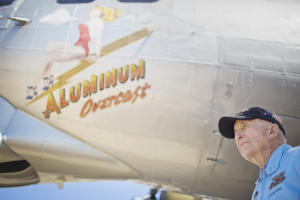Keeping the old warbirds in the air is an unusual challenge for crews who maintain planes such as the B-17 bomber Aluminum Overcast, which is touring the Southeast.
Only a handful of World War II airplanes are still airworthy, and crew members such as Terry Tucker and Meredith Whitlock travel with the planes to keep them going. The two aviation industry retirees were busy when the 69-year-old "Aluminum Overcast" had engine problems during a stop in Alabama.
"We're all volunteers," Tucker said. "Just for the love of aviation we come out."
The pilots had to feather one of the plane's four nine-cylinder engines when it was arriving in Montgomery because of an oil pressure problem, and the same problem cropped up again when the plane attempted to take off on a flight for World War II veterans.
"This is part of the experience of what they actually went through in combat. Hurry up and wait," pilot Ken Morris said after turning off the plane's engines because of the problem.

Tucker and Whitlock worked until after dark at the Montgomery airport cleaning filters so the plane could take off for flights the next day.
Flights cost $449 a person, and the plane holds a maximum of 10 passengers. Tucker said it costs more than $3,000 an hour to keep the plane in the air, so the revenue is important.
While mechanics sometimes have to fabricate parts, the Experimental Aircraft Association owns the B-17 and has a warehouse full of replacement parts to fix it in Oshkosh, Wisconsin.
"The most trying problems are engine problems," Tucker said. "If you lose an engine or lose a cylinder or anything it's quite time-consuming, and then hunting up parts to get for it."
The work can be tough, and it's nothing for crew members to be splattered with oil after a repair. But it's all worth it once a veteran such as Robert Scroggins climbs aboard.
Scroggins, 92, served as a B-17 bombardier during World War II and was on three planes that went down under enemy fire, including one that ditched in the North Sea.
Once Aluminum Overcast was repaired, the Tallassee man went on a flight over central Alabama and got to spend a few minutes sitting in the bombardier's seat in the plane's glass nose. He emerged afterward with a big grin.
"That was really great to be able to sit in that bombardier's seat one more time after all these years," Scroggins said.
(Jay Reeves - Associated Press)
No comments:
Post a Comment